Welcome to Card Game DB
Register now to gain access to all of our features. Once registered and logged in, you will be able to create topics, post replies to existing threads, give reputation to your fellow members, get your own private messenger, post status updates, manage your profile and so much more. If you already have an account, login here - otherwise create an account for free today!
Register now to gain access to all of our features. Once registered and logged in, you will be able to create topics, post replies to existing threads, give reputation to your fellow members, get your own private messenger, post status updates, manage your profile and so much more. If you already have an account, login here - otherwise create an account for free today!
Get Off My Fiefdom: Valar Morghulis
Nov 08 2016 08:00 PM |
Ire
in Game of Thrones
Get off my fiefdom Valar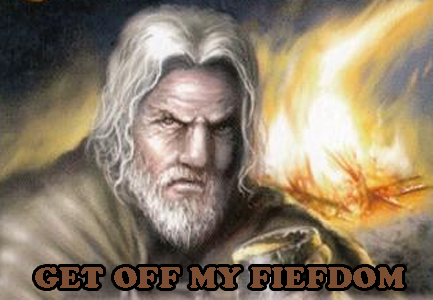 In this article series the main focus is to put all of you ‘know nothing green boys’ back into your place and tell about the real times of A Game of Thrones LCG. We will take glances on the true and proper Game of Thrones, which 2.0 players have no idea on. We might even touch on the CCG, if we happen to find old enough bastards to tell us how things were back in the days of the First Men.
In this article series the main focus is to put all of you ‘know nothing green boys’ back into your place and tell about the real times of A Game of Thrones LCG. We will take glances on the true and proper Game of Thrones, which 2.0 players have no idea on. We might even touch on the CCG, if we happen to find old enough bastards to tell us how things were back in the days of the First Men.The History of Valar
So all the 1.0 greenboys who started during the reign of Maester King Robert M.D will tell you that Valar is where the game is at and all you need is Valar... bah rubbish!
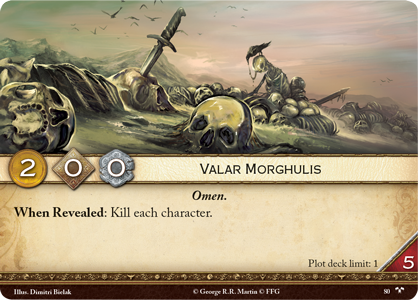
In my days we probably would have laughed at the guy who would claim that all men must die, even more so if the poor sod actually did try it.
Now in the good old days we had no such talk and Wildfire Assault was where the dying happened, if even then. Honestly, during the good ol’ days people didn’t die that often. We had too much Power in our Blood and too little time to die. However what we found time for, was kneeling. And we did lots of it. Unlike today's wishy-washy kneel once a day to R'hllor Melisandre... truly, what kind of joke has this game become?
While I simply do not have the knowledge on how things were with Valar Morghulis during the CCG times, I did find a person who was willing to share his greater knowledge on the subject so that we can have a full picture on what Valar was about in the dawn of the game.
Memoirs of the CCG days long gone
Whoo boy, would you believe this is the third time that I’ve played A Game of Thrones in a period in which Valar Morghulis was not available?
When I started the game in late 2002, not long after the release of the original base set, Westeros Edition, Wildfire Assault was the only reset available to us. Sure, there were other plots that could remove characters from play, like Rioting, but Wildfire was the only widely destructive card effect that we’re used to thinking of as a reset. Unsurprisingly then, the environment at the time really didn’t look that different from today in the broad strokes. Key characters like Robb Stark or Robert Baratheon had a real ability to stay on the board and take over games. Particularly frustrating to some was the difficulty in stopping a player gaining a great deal of power on their characters, as players would simply choose to keep those characters when Wildfire was revealed. This lead to a reliance on the challenge response events Tears of Lys and Put to the Sword as the primary means of character death outside of military claim.
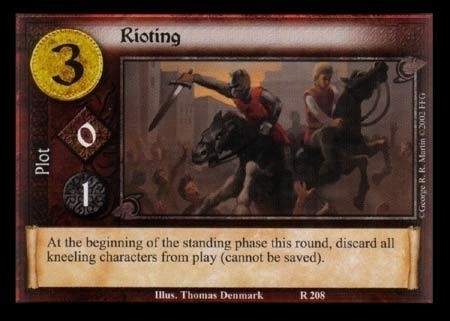
This all changed with the release of A Sea of Storms, the first expansion for the game. Not only did this set introduce House Greyjoy to the game along with their historic penchant for saves, but it also introduced the now iconic plot, Valar Morghulis. At the time, this plot blew up players’ expectations. Many of us had come from a Magic: the Gathering or other CCG background where such a wide reaching destructive effect had never been available on demand. Sure, there were some players who were unhappy at having to adjust their playstyle, but overall, I remember the community response as kind of a mystified approval. We couldn’t quite believe that they had really gone there, and yet the phrase meaning “All Men Must Die†was so iconic and the effect such a strong correlation that we couldn’t help but feel that it fit. That said, even with Greyjoy’s introduction, usage at the time was primarily defensive as people worked through the best pacing and situations to utilize it and how to come back from its use, both for the player who had revealed it and the player who had it revealed against them.
In short order, it became a hallmark of the game; a tool that I (and others) used to recruit new players with tales of an on demand board wipe, as well as a critical pressure valve in the expansion of board states. Fast forward then a couple of years to the release of Winter Edition. Surely the fact that CCGs utilize rotation schemes comes as no surprise and FFG took the opportunity of Valar Morghulis rotating out at this point to try something new with the release of the new base set. They decided that since Valar had become so ubiquitous, it was time to trade that toy in for a while and see what the environment could look like without it.
Of course, they still acknowledged the need for wide character resets and gave us something with a new twist. Playing off of the iconic “Winter is Coming†phrase, they crafted a set of Winter traited plots that effectively culminated in Winter Has Come. This was a 3 Gold, 4 Initiative, 1 Claim plot which killed all characters when it was revealed. Sounds pretty amazing compared to Valar, right? Well, it came with two additional features. Those characters could not be saved (even better!) but you could only do this if there were at least two other Winter plots in your used pile. This meant that the earliest you could use this to clear the field was on turn three. This, along with the existence of another plot called Outmaneuver (which canceled an opponent’s revealed plot and forced them to reveal a new one) led to a wild resurgence in the popularity and viability of Rush decks of all stripes.
I remember the desperate fight to keep the opponent off of 15 power for at least two turns, and then try to bring the game back to a pace you could compete at. This is also the genesis of my preference for utilizing two reset plots, as I would frequently reveal Wildfire Assault on turn three, knowing my opponent would likely use Outmaneuver and I could then switch to Winter Has Come. And, if they didn’t then I hopefully had dialed things back enough to last another turn or two!
While some players enjoyed the change of pace with Valar not being in the card pool, many others also acknowledged the gameplay shortcomings of Winter Has Come and so there was great fanfare and approval when Valar Morghulis returned to the game in the Iron Throne Edition base set. This set was billed at the time as a kind of “rose tinted glasses†view of Westeros Edition AGoT and as such, is probably viewed by most who played at the time as the golden age of Thrones. Here draw was prevalent, though not so equally spread as now, but most importantly, the environment was resource rich. In comparison to today’s cardpool, it was much easier to establish resources that would serve you to weather the loss of your characters and allow you to repopulate the table, particularly if you were the one that revealed Valar Morghulis. This was a time when planning, pacing, and the careful ebb and flow of cards in and out of play dictated the game for nearly every house. But maybe I’m looking back on it through a certain set of glasses.
- Will “Kennon†Lentz
The LCG first edition early meta
While it has been said that Valar is what defined Game of Thrones LCG during the first edition, it took quite long time for it to actually become a bigger force in the meta. For this there were several reasons:
- Where the meta was
- Counters
- Too many saves
- Not being impactful enough for the tempo hit
To understand better what Valar Morghulis as a card actually is, and how it will affect the Second Edition of the game, we should look back and see when it started to impact the meta and why it took so long for it to get to where it was - a meta defining plot of many great plays and stories.
In the early days of first edition the meta was heavily defined by 2 decks. Baratheon Power of Blood Rush and Lannister Hyper-Kneel. While Baratheon tried to squeeze out a win as fast as possible, the Lannister looked to have enough kneel to stop Baratheon from dominating the game with all their renown & supplemental power-gain rush. Stark and Targaryen had quite a bad Core pool to work with. They had a chance to beat the Lannister deck when built to deal with it, but the Baratheon deck was just too fast for them to handle consistently. Not even mentioning Greyjoy and Martell, since they only had their House cards in the Core box and only became somewhat viable with their own deluxes.
The rush tools for Baratheon in the core box have often been overlooked during the later times of the LCG, but most of them were just efficient bombs during the launch, which would be quite ridiculous in the second edition if they were printed. While most players still remember Fat Bob most have forgotten how good Stannis Baratheon was in the early days. So basically a free unopposed and renown everytime he attacks if you are not playing a mirror match… easily comparable to f.ex. 2.0 Balon Greyjoy.
So if Rush was the deck to beat, why didn’t Valar see much play? It would seem like power on characters would be vulnerable to Valar?
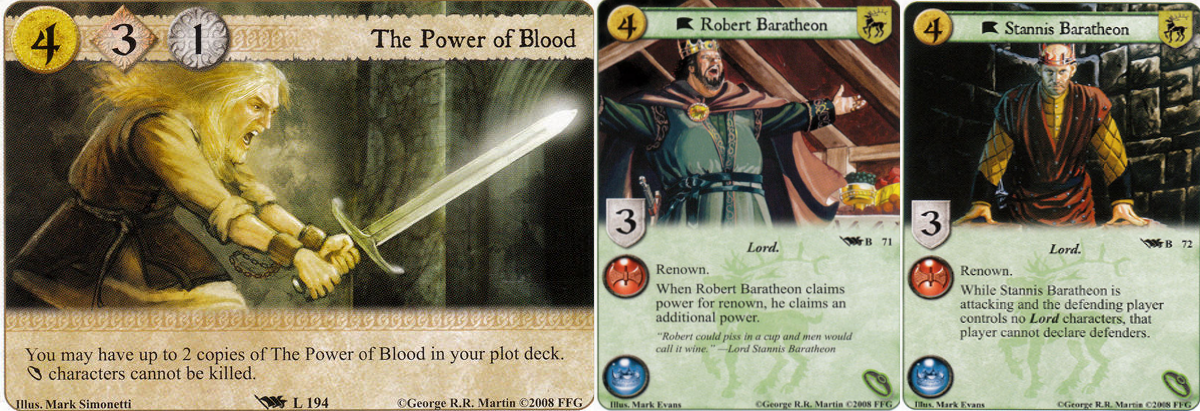
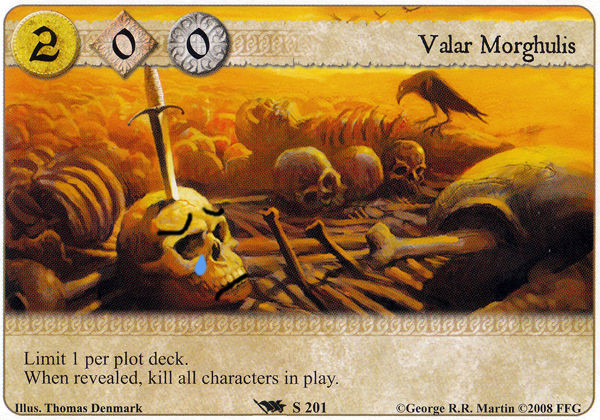
Probably the biggest reason why Valar didn’t have big impact on the early meta was Power of Blood, which gave the rush deck 2-3 rounds to just gather power without the fear that an important character would die. Those 2 rounds were enough and the mind games of “will he valar now or later†rarely was worth it for the non-Rush decks.
Now, that isn’t to say that Valar was not played, but it mostly was a “Plan B†play… often from the Rush decks themselves! The game for them rarely went to plot 7, so it was a safe play to have it just in-case there was a situation that called for it… They were running a bunch of saves & dupes anyway, so it didn’t really need any adaptation.
Let’s take a simplified look on the early meta and metashifts in the first edition to the point where we get to the much talked “Valar Metaâ€.
- Core meta: Nope.
Too heavy Rush meta for Valar to be relevant as meta changer. - 1st cycle: Nope.
Nothing new added. - 2nd cycle: Something is happening with Valar!
The small surge of Greyjoy with their Deluxe made offensive Valar a thing. Baratheon Rush started to diminish as other houses gained more tools and were able to challenge the Rush with better board presence. Lannister took their usual role of “best deck in the meta†and started to use Valar more as the Rush matchup wasn’t quite as likely. Greyjoy got it’s deluxe and winter theme, while not seeing a lot of play, it still managed to sneak in a Worlds win - here is an excellent article from Greg Atkinson to get better image on what the meta was like and on how the first edition game played during this era:
Valar Dobblerus - 3rd cycle: Greyjoy still has the best use of Valar, still not meta defining.
Bigger meta shifts in Shadows being viable and Lannister kneel becoming even stronger of a force. Shadows also created a Valar and intrigue safe zone which players could use to keep key shadows characters in until they were needed to swing the game for a win. Martell finally becomes playable thanks to it’s own deluxe box and the addition of first edition Venomous Blade which made nearly all 2 STR and lower characters almost unplayable. - 4th cycle: You thought it was getting better? Nope all the way down to zero impact.
With this cycle we cannot talk anymore about meta shifts, meta was completely re-defined. The whole 6-agenda meta could make a good article on it’s own, but simply put the meta was all about Aggro (9 STR deadly + stealth armies for 1g anyone?) and Valar was too big of a tempo loss to play against the 6-agenda decks. The 6-agenda decks often fielded 5-7 two claim plots to keep the pressure at maximum and they were full of big beefy cheap stealthy characters - the downside of the 6-agenda decks was that they needed 27 power to win. Lannister no longer was at the top spot, as its place had been taken by Stark 6-agenda & Martell 4/6-agenda decks… - 5th cycle: Valar is… starting to rise.
The rise of Valar was put in motion once the 6-agenda decks took a heavy nerfing in the FAQ with severe restrictions to the agendas, which stopped the 6-agenda nonsense. Since the Wildlings and Night’s watch beefy characters were not used as heavily anymore, burn finally got to use its shiny new toys to liquify characters - together with Martell (and later Lannister) becoming good at cancelling dupes, this caused a meta reaction to run more unique characters as 1x... which in turn fed into making Valar more powerful. The 5th cycle also brought in a completely new Valar player with the Brotherhood agenda and Valar became offensive tool for everyone who could utilize the unkillable Beric Dondarrion. - 6th cycle: VALAR META IS HERE TO STAY! Also, Maesters.
I won’t go through with how Valar was utilized during its golden era as Kennon has written two great articles on the subject. I recommend both of these articles for anyone who wants to know more about Valar Morghulis and why there is such a big fuss about it:
Crafting The Theory - All Men Must Die
Crafting The Theory - The Effects of Valar
By knowing the history of the plot we can also picture more clearly on how it will be used in the second edition and in what kind of meta it will see play... and for what purposes.
- From the earlier points we know that Valar cannot handle save heavy decks and it gets even more restrictive once you get cannot be killed into the equation. Now, that being said, those decks can themselves utilize Valar for a very different purposes, but it gets muddled if the Meta fills too much with decks that want to Valar on offense.
- If everyone is playing Big Dudes & Cheap Chuds decks, which heavily rely on tempo... even decks which can use offensive Valar are unable to find a spot for it as revealing Valar can get you overwhelmed as the opposition can refill the board with more Big Dudes and Chuds while you are staring at your 2 income and 0 claim. Most likely in this kind of meta the 2-claim plots will be more popular and... well, 2 claim plots are quite easy counters to Valar.
- If saves are discouraged, then Valar will rise in popularity, especially if Burn gets stronger. Then I would guess that we will see plenty of Valar.
- Anything which makes Valar rise in popularity will also cause the deck building to be more centered around playing most uniques as 1x and the most important unique characters as 3x (with less 2x middle-ground).
- The more Valar sees play, the more draw becomes important. While currently we don’t see much of the in-Faction draw locations except Red Keep, the others should start to see more play since with Valar running around you will want to have bigger hand to utilize after the board has been wiped.
- Locations get more important as Valar rises in power. Simply put, locations are safe from Valar, which makes them more stable to play.
- Negative non-terminal attachments will be even more powerful. If Imprisoned and their like already weren’t good enough you can imagine what happens once you start killing lots of dudes and getting them back again.
- Valar shifts the importance of economy back from dudes (like Tywin & Tyrion) to resource Locations (like Arbor & Bear Island), which can have an interesting impact on House economic efficiency.
Disclaimer: Subjects talked in this article may differ from your own experiences, this is mostly how things worked in the EU meta and on the meta discussion on the old FFG boards. The word “dudes†was heavily used in honor of Drakey.
- WWDrakey, scantrell24, JCWamma and 23 others like this



 Sign In
Sign In Create Account
Create Account











7 Comments
Well done, dear sir. I have been looking for such article for a very long time. It fills my needs perfectly.
Love it
Excellent analysis. It may not see much play for a while, but the fact that it exists and can be played will fundamentally alter deck building.
I think Tyrell will be able to use it with their gold and card advantage, and Greyjoy with their saves and Claim replacement. I think Tyrell-Kraken will start to see play.
Yeah I would say the use of Valar fluxuated the most around KL where at the end of the cycle one of the favorite Lannister ways was to gather enough power, valar away the board and grab a lot of power with shadow Tyrion and Kingdom of Shadows stading him. It defnitely was nearly there at the end of the cycle - but yeah 6-agendas.Spanish meta at the time was one of the most competitive metas there was (though before agotcards hearing news from it to outside metas wasn't all that usual) so hearing Valar had more impact there isn't too surprising.